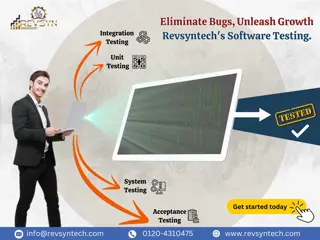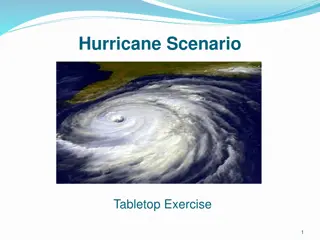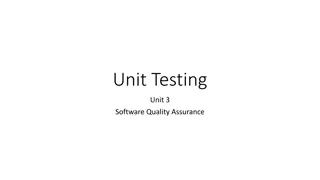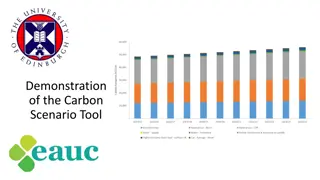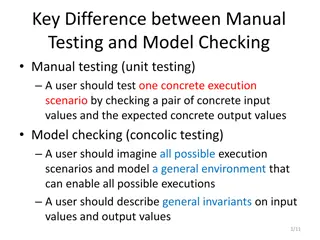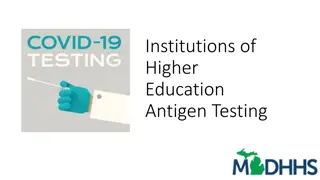Real Testing Scenario Strategy in a TestOps Environment
Learn about testing tiers, tools for testing challenges, sample architecture for web-based applications, and explore the agenda covering requirements, manual/unit/UI/load/API testing, CI server integration, and reporting. Understand the importance of defining requirements and developing a test strategy in various methodologies like Agile and Waterfall. Get insights into test and development strategies, acceptance testing, automation, version control, continuous integration, and more.
Download Presentation

Please find below an Image/Link to download the presentation.
The content on the website is provided AS IS for your information and personal use only. It may not be sold, licensed, or shared on other websites without obtaining consent from the author. Download presentation by click this link. If you encounter any issues during the download, it is possible that the publisher has removed the file from their server.
E N D
Presentation Transcript
Real Testing Scenario Strategy: A Real-life TestOps Environment By Adam Sandman Inflectra Corporation June 21st, 2017
About Me Adam Sandman was a programmer from the age of 10 and has been working in the IT industry for the past 20 years. Currently Adam is a Director of Technology at Inflectra Corporation, where he is interested in technology, business and innovation. Adam lives in Washington, DC with his family and is excited to be visiting Israel after an absence of 35 years.
Objectives Learn about the different tiers of testing Understand how tools can address the challenges of testing each tier See a sample architecture for a typical web- based multi-tier application Ask me lots of challenging questions, so that I get over my jet lag!
Agenda Requirements Discovery and management, linked to: Manual testing Unit testing (e.g. NUnit, MS-Test, Junit) UI testing with Rapise Load testing with NeoLoad or JMeter API Testing with Rapise Connecting to CI server such as Jenkins. Dashboards and reporting
What Are We Going to Test? A simple n-tier ASP.NET web application:
What Are We Going to Test? Also We Need to Test Its RESTful APIs:
So What Do We Need to Do First? Define Our Requirements Develop Our Test Strategy
What Are The Requirements? We need a set of requirements to write our tests, regardless of whether we re using an Agile or Waterfall methodology.
What Our Our Requirements? Traditional Requirements Matrix Agile User Stories
Now Whats Our Test & Dev. Strategy Requirements, User Stories, etc. Acceptance Tests Session Testing Automated Tests (Checks) Subversion Test Environments Continuous Integration (Jenkins) Git Installation Process Source Code Mgt.
There Is Never Enough Time for Testing You should not seek to automate 100% of all your tests, because manual testing and automated testing are more efficient at different things
What Tests Should We Automate? Automate the repetitive, stable, unchanging, boring things that are ideal for automated testing Let manual testing find the lurking items that you don t even know exist (yet!) and cannot automate.
Continuous Integration (CI) Ensure that you have a robust set of smoke tests that can run after every CI build Unit, API and Automated UI tests
Monitoring Test Activities In the next sections we will discuss the different types of testing. It is important to be able to monitor all testing activities and track key metrics Requirements test coverage Code test coverage Regression coverage of at-risk areas
Monitoring Test Activities Modern test management tools include powerful dashboards and reports.
Unit Testing Unit test frameworks are chosen for each technology you use: Java Development jUnit or TestNG .NET Development NUnit or MS-Test Similar frameworks for Ruby, Perl, Python, JS, C Tie them into your test management platform if possible
API / Service Testing APIs are now more important than the applications Business Models such as UBER or AWS Rely on APIs You need to regression every version of the API you support
API / Service Testing Tools such as SOAP-UI, Rapise, POSTman can test different APIs Some are limited to SOAP, REST, etc. others cover multiple types Make sure you tie them back into your test management system
Automated User Interface (UI) Testing A lot of business rules, functionality still in the UI layer Automate the parts that are stable and time consuming to manually test. Beware the negative ROI of testing 100% of a highly changing UI. Humans deal with change better* (*until AI solves it!)
Automated User Interface (UI) Testing There are various UI testing tools available: Free tools such as Selenium, Appium, etc. require you to be a programmer Commercial tools such as Rapise, Ranorex, UFT, TestComplete make it easier for the non-programmer Choose the tool(s) that work with your application and your testing team s skill level
Non-Functional Testing Don t leave Performance Testing Until the End (*Big Mistake*) There are many tools to choose from (JMeter, NeoLoad, LoadRunner, etc.) Make sure you tie it into your test management platform
Manual Testing / User Testing There are many good test management tools to choose from. Don t default to using Excel, Google Sheets Understand UAT manual testing vs. Exploratory Testing They are different and should be used appropriately


